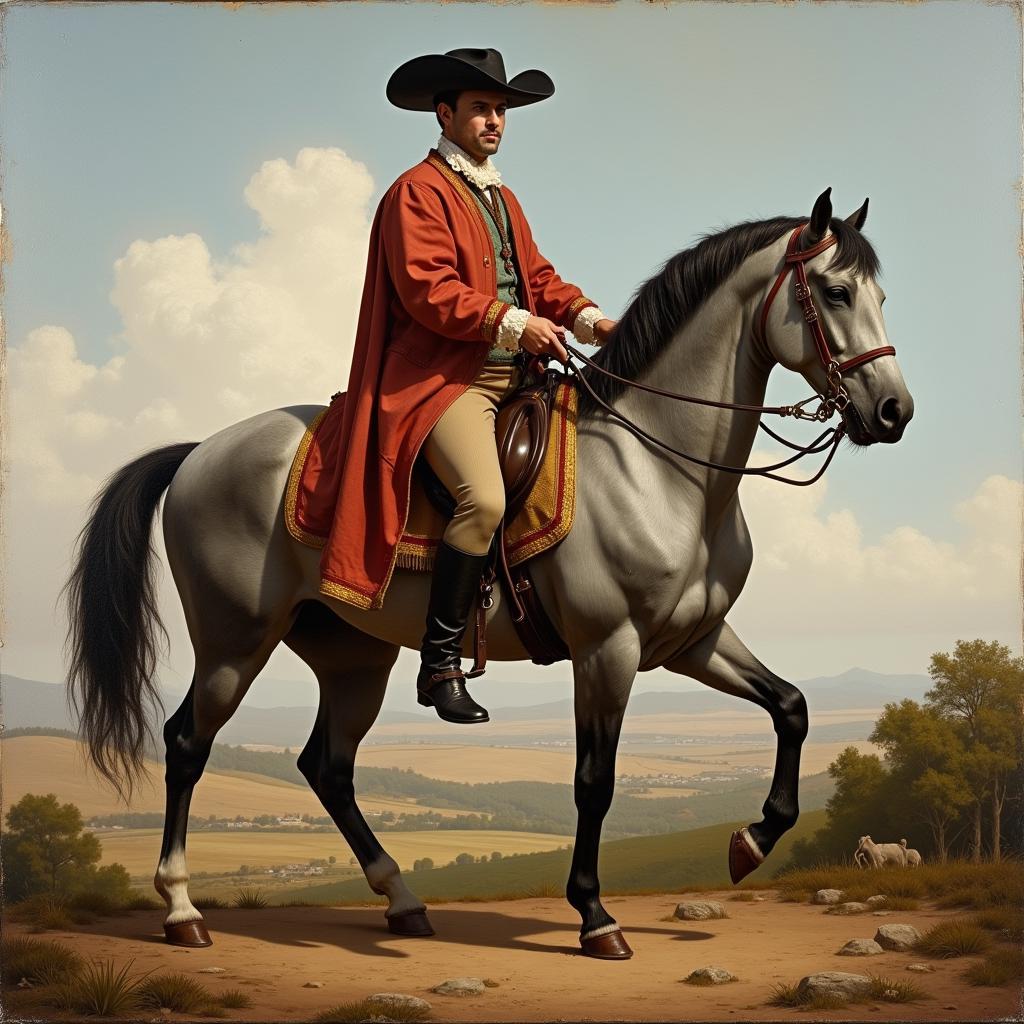The Gray Andalusian Horse, a breathtaking breed with a rich history and captivating presence, is a true embodiment of power and grace. Known for its stunning silver coat, flowing mane, and elegant movement, the Gray Andalusian has captivated horse enthusiasts for centuries. In this comprehensive guide, we’ll delve into the fascinating world of the Gray Andalusian horse, exploring its origins, temperament, uses, and what it takes to care for these majestic creatures.
Unveiling the History of the Gray Andalusian
The Gray Andalusian, also known as the Pure Spanish Horse or PRE (Pura Raza Española), originated in the Iberian Peninsula, specifically in the region of Andalusia, Spain. Its roots can be traced back thousands of years, with evidence suggesting its ancestors roamed the peninsula as far back as prehistoric times. Over the centuries, the breed was influenced by various civilizations, including the Carthaginians, Romans, and Moors, each contributing to its unique characteristics.
 Gray Andalusian Horse in Historical Context
Gray Andalusian Horse in Historical Context
During the Middle Ages, the Andalusian horse gained immense popularity among European nobility, becoming a symbol of prestige and power. Their intelligence, trainability, and stunning looks made them ideal for both war and classical dressage. The Spanish conquistadors rode Andalusians during their explorations, introducing the breed to the Americas in the 16th century.
The Distinctive Characteristics of the Gray Andalusian
The Gray Andalusian is a medium-sized horse, typically standing between 15.2 and 16.2 hands high. While they are known for their gray coats, Andalusian horses are born with dark skin and hair. The gray coloration develops gradually over time as they age, with most individuals displaying a fully gray coat by the time they reach six to eight years old.
Beyond their striking color, Gray Andalusians possess a range of distinctive physical attributes, including:
- A well-proportioned head with a slightly convex or straight profile.
- Large, expressive eyes that reflect their intelligence and sensitivity.
- A strong, arched neck set high on the withers.
- A compact, muscular body with a deep chest and sloping croup.
- Strong, well-formed legs with good bone density.
- A thick, flowing mane and tail that enhance their majestic appearance.
 Gray Andalusian Horse Conformation
Gray Andalusian Horse Conformation
Temperament and Trainability: A Willing Partner
Known for their intelligence, willingness to learn, and gentle disposition, Gray Andalusians are highly trainable and eager to please their riders. Their sensitivity, while a positive trait, also means they require a skilled and experienced handler who can provide consistent training and build a strong bond.
Versatility in the Ring and Beyond
Gray Andalusians excel in a variety of disciplines, showcasing their versatility and athleticism:
-
Dressage: Their natural grace, balance, and ability to perform advanced movements make them a popular choice for dressage competitions.
-
Driving: Their strength and stamina, combined with their calm temperament, make them well-suited for driving.
-
Working Equitation: The breed’s intelligence, agility, and athleticism are well-suited for working equitation, which combines dressage movements with obstacles that test the horse’s obedience and partnership with the rider.
-
Film and Entertainment: Their stunning looks, presence, and trainability have made them highly sought-after for roles in movies, television shows, and live performances.
 Gray Andalusian Horse in Dressage Competition
Gray Andalusian Horse in Dressage Competition
Caring for a Gray Andalusian Horse
Providing proper care for a Gray Andalusian is essential for ensuring their health, well-being, and longevity. Like all horse breeds, they require:
- A balanced diet: High-quality hay, grain, and fresh water are crucial.
- Regular exercise: Turnout time, riding, or other forms of physical activity are important for maintaining their physical and mental health.
- Routine veterinary care: Vaccinations, deworming, and dental checkups are essential.
- Hoof care: Regular trimming or shoeing by a qualified farrier is necessary.
- Grooming: Andalusians benefit from regular grooming to keep their coat and skin healthy and clean.
Finding Your Own Gray Andalusian Horse
If you’re captivated by the allure of the Gray Andalusian, researching reputable breeders or rescue organizations is essential. Purchasing a horse is a significant decision, and it’s crucial to find a horse that is a good match for your riding experience, goals, and lifestyle.
FAQ: Gray Andalusian Horses
Q: How long do Gray Andalusian horses live?
A: The average lifespan of a Gray Andalusian horse is between 25 and 30 years, with proper care and management.
Q: Are Gray Andalusian horses good for beginners?
A: While known for their gentle nature, Gray Andalusians are best suited for intermediate to experienced riders due to their sensitivity and athleticism.
Q: What are some common health concerns in Gray Andaluusians?
A: Like all breeds, Gray Andalusians are prone to certain health issues, including laminitis, equine metabolic syndrome, and certain types of cancer. Regular veterinary care is crucial for early detection and management.
Explore Other Majestic Breeds
If you’re interested in learning about other captivating horse breeds, explore our articles on the Gram horse, the Farm Rio horse, or the Carolina Marsh Tacky horse.
Need More Information on the Gray Andalusian?
For any questions or assistance in finding the perfect equine companion, don’t hesitate to reach out. Contact us at Phone Number: 0772127271, Email: [email protected] or visit our address: QGM2+WX2, Vị Trung, Vị Thuỷ, Hậu Giang, Việt Nam. Our dedicated team is available 24/7 to assist you.